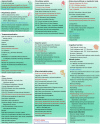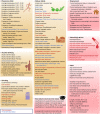Phenome-wide investigation of the causal associations between childhood BMI and adult trait outcomes: a two-sample Mendelian randomization study
- PMID: 33771188
- PMCID: PMC8004431
- DOI: 10.1186/s13073-021-00865-3
Phenome-wide investigation of the causal associations between childhood BMI and adult trait outcomes: a two-sample Mendelian randomization study
Abstract
Background: Childhood obesity is reported to be associated with the risk of many diseases in adulthood. However, observational studies cannot fully account for confounding factors. We aimed to systematically assess the causal associations between childhood body mass index (BMI) and various adult traits/diseases using two-sample Mendelian randomization (MR).
Methods: After data filtering, 263 adult traits genetically correlated with childhood BMI (P < 0.05) were subjected to MR analyses. Inverse-variance weighted, MR-Egger, weighted median, and weighted mode methods were used to estimate the causal effects. Multivariable MR analysis was performed to test whether the effects of childhood BMI on adult traits are independent from adult BMI.
Results: We identified potential causal effects of childhood obesity on 60 adult traits (27 disease-related traits, 27 lifestyle factors, and 6 other traits). Higher childhood BMI was associated with a reduced overall health rating (β = - 0.10, 95% CI - 0.13 to - 0.07, P = 6.26 × 10-11). Specifically, higher childhood BMI was associated with increased odds of coronary artery disease (OR = 1.09, 95% CI 1.06 to 1.11, P = 4.28 × 10-11), essential hypertension (OR = 1.12, 95% CI 1.08 to 1.16, P = 1.27 × 10-11), type 2 diabetes (OR = 1.36, 95% CI 1.30 to 1.43, P = 1.57 × 10-34), and arthrosis (OR = 1.09, 95% CI 1.06 to 1.12, P = 8.80 × 10-9). However, after accounting for adult BMI, the detrimental effects of childhood BMI on disease-related traits were no longer present (P > 0.05). For dietary habits, different from conventional understanding, we found that higher childhood BMI was associated with low calorie density food intake. However, this association might be specific to the UK Biobank population.
Conclusions: In summary, we provided a phenome-wide view of the effects of childhood BMI on adult traits. Multivariable MR analysis suggested that the associations between childhood BMI and increased risks of diseases in adulthood are likely attributed to individuals remaining obese in later life. Therefore, ensuring that childhood obesity does not persist into later life might be useful for reducing the detrimental effects of childhood obesity on adult diseases.
Keywords: Adult outcome; Causal; Childhood BMI; Mendelian randomization.
Conflict of interest statement
The authors declare that they have no competing interests.
Figures





References
-
- Ng M, Fleming T, Robinson M, Thomson B, Graetz N, Margono C, et al. Global, regional, and national prevalence of overweight and obesity in children and adults during 1980-2013: a systematic analysis for the Global Burden of Disease Study 2013. Lancet. 2014;384(9945):766–81. 10.1016/S0140-6736(14)60460-8. - PMC - PubMed
-
- Simmonds M, Burch J, Llewellyn A, Griffiths C, Yang H, Owen C, Duffy S, Woolacott N. The use of measures of obesity in childhood for predicting obesity and the development of obesity-related diseases in adulthood: a systematic review and meta-analysis. Health Technol Assess. 2015;19(43):1–336. doi: 10.3310/hta19430. - DOI - PMC - PubMed
Publication types
MeSH terms
LinkOut - more resources
Full Text Sources
Other Literature Sources

